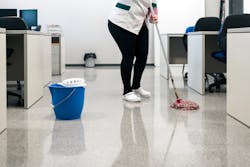The two most commonly used floor covering types found in schools are carpet and resilient floor covering products. Both types can affect indoor air quality, the U.S. Environmental Protection Agency says.
“Interior building materials — including carpets, carpet padding, paints, sealants and caulking, adhesives, floor and ceiling tiles...can contain contaminants that are gradually emitted throughout the life of the material,” the EPA says. “The contaminants include volatile and semi-volatile organic compounds (VOCs), and small particulate substances that act as eye or throat irritants.”
Carpet offers acoustical and comfort benefits that are generally not available with other floor coverings, the EPA says. Many schools prefer to use carpet in classrooms and administrative areas.
Resilient flooring is more often found in high-traffic areas such as classrooms, hallways, cafeterias, art rooms, restrooms and anywhere liquid spills are likely.
“While there is currently considerable debate about the most appropriate flooring material for use in schools, EPA recognizes that there are advantages and disadvantages to any flooring system,” the agency says. “Regardless of floor covering type specified, regular and effective cleaning and maintenance is essential to keep the floor covering dry and clean.”
Carpet cleaning
“To help ensure longer life, maintain appearance, and help protect indoor air quality, carpet requires regular vacuuming with a well-functioning vacuum cleaner equipped with strong suction and a high-performance filtration bag and periodic wet extraction cleaning.”
If kept very clean from the time it is installed, carpet can trap a significant amount of particles, which can be removed through regular and effective vacuuming. However, the EPA warns, inadequate maintenance can result in large quantities of dust and debris building up in carpet. Some studies indicate that poorly maintained carpet can release significant quantities of particles into the air during daily activity.
If carpet is specified, the EPA recommends selecting a carpet that has been tested for VOC emissions under the CRI IAQ Green Label Plus testing program; can be easily cleaned and maintained; is constructed to prevent liquids from penetrating the backing layer where moisture under the carpet can result in mold growth; and can be easily removed without the use of toxic chemicals.
To minimize odor from new carpet, schools should require suppliers to unroll and air out carpets in a clean, dry warehouse before bringing them into the building. Schools also should specify the least toxic carpet adhesive system compatible with the selected carpet. Installers should use the smallest amount of adhesive necessary to fulfill the manufacturer's performance specifications for that product. Schools also may decide to specify tack-down carpet to eliminate gluing.
Resilient flooring
Resilient flooring materials, like most new interior finishing materials, will off-gas VOCs for some time after being installed. Adhesives used to install and materials used to clean and maintain resilient flooring also may be a source of VOC emissions. The impact of resilient flooring on indoor air quality varies by flooring material, installation method and maintenance procedures.
If resilient flooring is chosen for a school space, planners should select a floor that has been tested for VOC emissions under the Resilient Floor Covering Institute FloorScore program; that can be easily cleaned and maintained with low-VOC cleaners and finishes, and that can be installed with low-VOC adhesives and coatings to minimize the indoor air pollution load and health risks to installers and occupants.
Schools should consult with manufacturers when specifying maintenance materials for resilient flooring, the EPA recommends. Use of the wrong maintenance materials can damage resilient flooring.
As with carpets, schools should direct an installer of resilient flooring to use the smallest amount of adhesive necessary to fulfill the manufacturer’s performance specifications for that product.
For both resilient flooring and carpeting, schools should air out for a minimum of 72 hours the spaces where the product has been installed.
About the Author
Mike Kennedy
Senior Editor
Mike Kennedy, senior editor, has written for AS&U on a wide range of educational issues since 1999.
